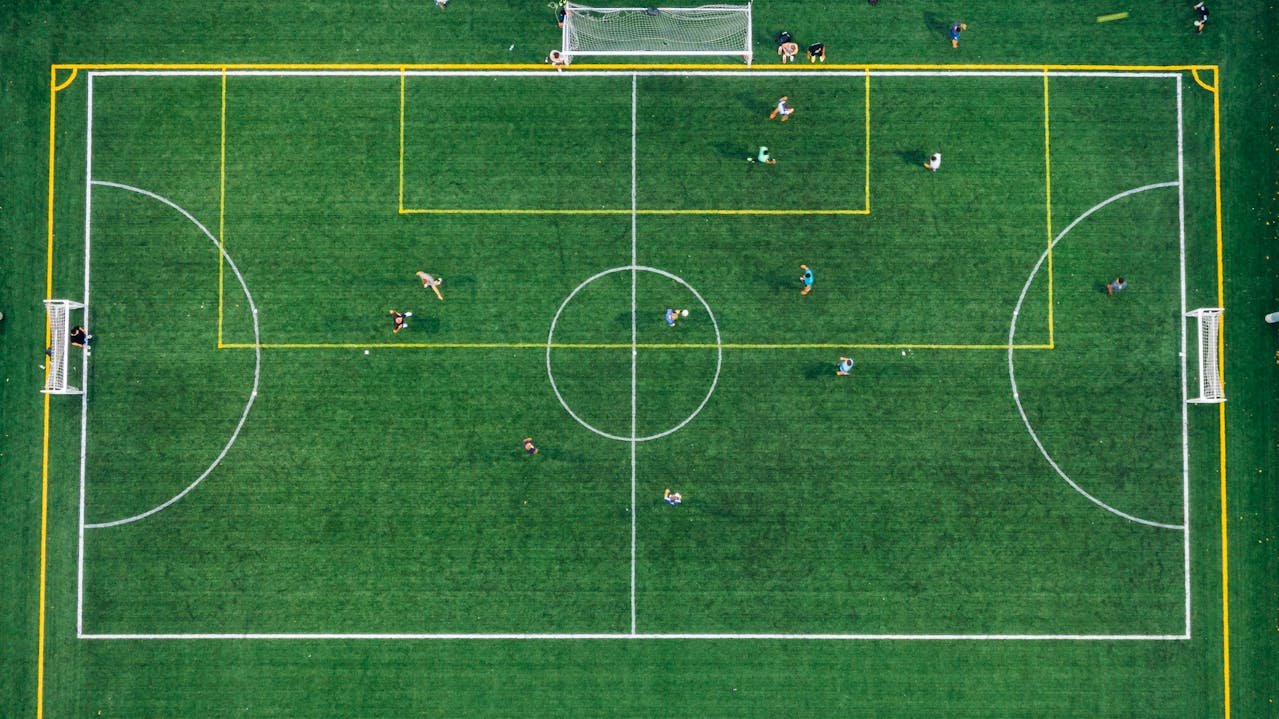Soccer pressing tactics are a game-changer when used correctly. Whether you’re playing for fun or at a competitive level, understanding how to press like a pro can give your team the upper hand. A well-organized press forces opponents into mistakes, wins the ball high up the pitch, and creates goal-scoring chances.
But pressing isn’t just about running at the ball. It’s about smart positioning, teamwork, and knowing when to apply pressure. Without the right approach, an aggressive press can backfire, leaving your defense exposed.
This article breaks down the most effective soccer pressing tactics, explaining different styles of pressing, key principles, and how to implement them in a match. By the end, you’ll understand how to press efficiently and disrupt your opponents without leaving gaps in your defense.
What Are Soccer Pressing Tactics?
Pressing in soccer refers to the strategy of applying pressure on the opposing team to force mistakes and regain possession quickly. Teams use pressing tactics to limit space, disrupt passing lanes, and force turnovers in dangerous areas.
There are different styles of pressing, each with its own strengths and weaknesses. The key is knowing which strategy suits your team’s playing style and adapting based on the opponent’s tactics.
Why Is Pressing Important?
Pressing isn’t just about chasing the ball—it’s a structured approach that can control a game’s tempo. Here’s why pressing is crucial:
- Forces mistakes: Opponents under pressure are more likely to misplace passes or lose control.
- Wins possession higher up: Winning the ball near the opponent’s goal creates better scoring chances.
- Limits opponent’s buildup: Pressing high prevents teams from comfortably passing out from the back.
- Disrupts playmakers: Pressing cuts off passing options for key playmakers, limiting their impact.
Understanding pressing tactics will help your team stay organized, apply pressure effectively, and avoid unnecessary chasing.
Types of Soccer Pressing Tactics
Different teams use different pressing strategies depending on their formation, fitness levels, and coaching philosophy. Here are the most common types:
High Press Soccer: How Does It Work?
The high press involves putting immediate pressure on the opposing defenders as soon as they have the ball. The goal is to win possession as close to the opponent’s goal as possible.
How it works:
- Forwards and midfielders press aggressively to prevent easy passes.
- Defenders push up to compress space, reducing passing options.
- The team works as a unit to close down opponents and force mistakes.
When to use it:
Against teams that play out from the back.
When your team has high fitness levels and can sustain intense pressing.
If the opponent’s defenders struggle under pressure.
Potential risks:
Can leave space behind the defense if the press is broken.
Requires excellent coordination and fitness.
Helpful Hint:
When executing a high press, always cut off passing lanes before charging at the ball carrier. A rushed press without cover can be easily bypassed.
Mid-Block Press: What Makes It Effective?
A mid-block press is a more balanced approach where the team defends in the middle third of the pitch. It’s less aggressive than a high press but still limits the opponent’s options.
How it works:
- Defenders stay compact in the middle of the field.
- Midfielders cut off passing lanes and pressure the ball.
- Forwards drop slightly deeper to help cover space.
When to use it:
Against teams that struggle to break down compact defenses.
When conserving energy for counter-attacks.
If the opponent relies on long balls rather than short passes.
Potential risks:
Can allow opponents time on the ball in deeper areas.
Requires discipline to stay compact and avoid chasing.
Low Block Press: Can It Still Be Aggressive?
The low block is a defensive pressing tactic where the team stays deep in their half, inviting pressure before trying to counter-attack.
How it works:
- Defenders stay close to their goal, forming a compact shape.
- Midfielders and forwards drop deep to support.
- Quick counter-attacks are launched when possession is won.
When to use it:
Against stronger teams with superior possession.
When protecting a lead in the final minutes.
If your team lacks speed to press high effectively.
Potential risks:
Gives the opponent more control over possession.
Requires fast counter-attacks to avoid being pinned back.
Counter-Pressing: What Happens Right After Losing the Ball?
Counter-pressing (or gegenpressing) is the tactic of pressing immediately after losing possession. Instead of retreating, players apply instant pressure to regain the ball quickly.
How it works:
- Players close down passing lanes instantly after losing possession.
- Multiple players press the ball carrier to force a mistake.
- The press lasts for a few seconds before transitioning to a defensive shape.
When to use it:
When attacking with many players forward.
If your team is well-drilled in pressing as a unit.
Against teams that take time to settle in possession.
Potential risks:
If the counter-press fails, it can leave gaps at the back.
Requires high intensity and coordination.
Stats:
Studies show that teams using counter-pressing tactics recover the ball in under 6 seconds 70% of the time, disrupting the opponent’s play.
Key Principles of Soccer Pressing Tactics
Pressing isn’t just about chasing the ball. It’s a coordinated effort that requires smart movement, discipline, and teamwork. Here are the core principles that make pressing effective:
1. Trigger-Based Pressing: When Should You Apply Pressure?
A successful press isn’t random—it’s activated based on specific triggers. These triggers signal when to press aggressively.
Common pressing triggers:
- An opponent receives the ball with their back to goal.
- A poor first touch or heavy pass that’s difficult to control.
- A risky pass across the defense or to the goalkeeper.
- When a team plays short goal kicks.
- Whenever a key playmaker is isolated with limited passing options.
Reacting to these triggers allows teams to apply pressure at the right moments, increasing the chances of forcing a turnover.
2. Pressing in Numbers: Why Teamwork Matters
Pressing is most effective when multiple players work together to surround the ball carrier and cut off passing options.
How to press in numbers:
- One player applies direct pressure on the ball.
- At least two teammates block passing lanes to force a mistake.
- Defenders and midfielders step up to compress space.
Pressing works best when players anticipate the opponent’s moves and move as a unit. If just one player presses without support, the opposition can easily bypass the pressure.
3. Body Positioning: How to Force the Opponent Into a Mistake
How you approach the ball carrier matters. The goal is to guide them into a difficult position.
Key body positioning tips:
- Angle your run to force the opponent toward the sideline.
- Use your body to block passing lanes and limit their options.
- Stay low and balanced to react quickly.
- Don’t rush in—wait for the right moment to commit.
Good body positioning prevents easy escapes and increases the likelihood of winning the ball.
How to Train Soccer Pressing: Drills to Improve Team Pressing
Training pressing tactics requires repetition, communication, and real-game scenarios. These drills will help your team improve pressing coordination.
1. Small-Sided Pressing Game
This drill improves reaction time and quick pressing after losing possession.
Setup:
- Create a 5v5 or 6v6 small-sided game in a confined area.
- Teams must immediately press upon losing possession.
- Encourage players to close down space and work together.
This drill simulates real-game pressing situations and teaches players how to react quickly.
2. 3v3+3 Pressing Drill
A drill that teaches pressing in numbers.
Setup:
- Divide players into three teams of three.
- Two teams keep possession while the third presses.
- If the pressing team wins possession, the losing team becomes the new pressers.
This drill improves pressing intensity and teamwork.
3. Half-Pitch Pressing Drill
A larger-scale drill that trains team pressing in match-like conditions.
Setup:
- Divide the field into three zones.
- The attacking team must pass through zones without losing possession.
- The defending team applies pressing in each zone.
This drill improves coordination across different areas of the field.
Helpful Hint:
Coaches should focus on communication during pressing drills. Players must constantly talk, signal when to press, and adjust positioning together.
Common Pressing Mistakes and How to Avoid Them
Even top teams make mistakes when pressing. Here are the most common errors and how to fix them.
1. Pressing Without Cutting Passing Lanes
Pressing is useless if passing options are still open. A player pressing alone without blocking the next pass makes it easy for the opposition to escape.
Solution: Always cut off passing lanes before closing in on the ball carrier.
2. Overcommitting Too Quickly
If a player rushes in too fast, a quick turn or simple pass can beat them.
Solution: Approach with control. Use your body to guide the opponent instead of lunging in.
3. Poor Defensive Line Coordination
Pressing fails if defenders don’t push up in sync with the midfielders and forwards.
Solution: Defenders must step up when pressing starts to prevent gaps in midfield.
Stats:
Teams with coordinated pressing recover possession 30% faster than teams with disorganized pressure.
Frequently Asked Questions
Wrapping Up
Soccer pressing tactics can significantly alter the course of a match, giving teams the ability to control the game and win the ball in dangerous areas. Whether you choose a high press, mid-block, low block, or counter-press, the key to success lies in coordination, smart positioning, and understanding when to apply pressure. By training your team to recognize pressing triggers, work together, and stay disciplined, you can disrupt your opponents’ rhythm and create more scoring chances.
Remember, pressing is not just about running after the ball; it’s a team effort that requires tactical awareness and precision. With practice and effective drills, your team can master these pressing strategies and elevate their game. Keep honing your pressing tactics to stay one step ahead of your opponents and maintain control of the match.





